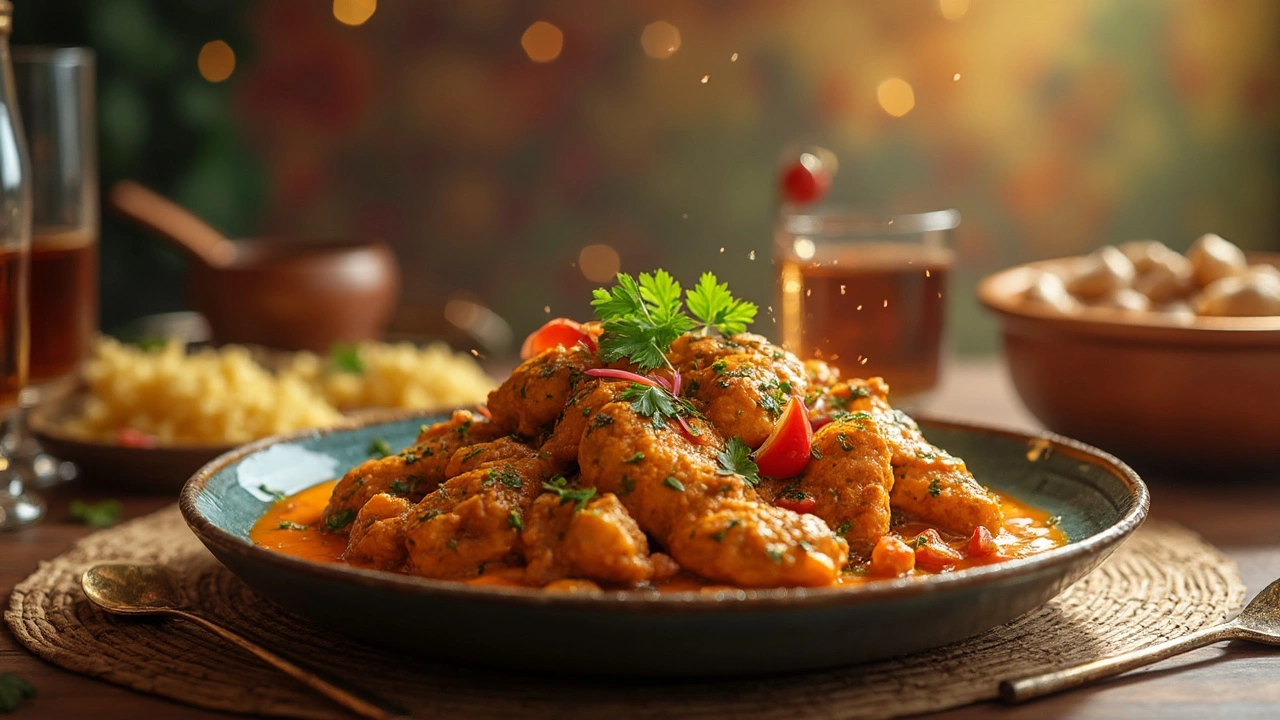25 Feb 2025
- 0 Comments
Ever heard of hing? Also known as asafoetida, this spice is a game changer for anyone avoiding onion and garlic, whether it's for dietary reasons, religious practices, or simply a change of taste. Its strong, pungent aroma mellows out into a savory, onion-garlic like flavor when cooked, making it an ideal substitute.
Dating back to ancient India, hing has been a staple in kitchens that steer clear of 'killers' of flavor, like onion and garlic. With its distinct aroma and savory undertones, it brings depth and a warm, umami boost to dishes. When you're whipping up a chicken curry, try mixing it with a bit of ghee to unlock its full potential. It's a tiny amount but packs a punch!
- The Magic Spice: Hing
- Cooking Without Onions and Garlic
- Benefits of Hing in Indian Cooking
- Spicing Up Your Chicken Curry
- Tips for Using Hing Effectively
The Magic Spice: Hing
Let's talk about hing, or asafoetida, a spice whose reputation in Indian kitchens is as ancient as the cuisines themselves. Often referred to as the 'devil's dung' due to its strong initial odor, hing works magic once it hits the pan. Cooking reduces its pungency, transforming it into a flavor enhancer reminiscent of onions and garlic.
Hing's journey to India is thought to have started from the deserts of what is today Iran and Afghanistan. Back in the day, it was even considered a cure-all—Greeks and Romans praised its medicinal properties.
In the kitchen, hing is mostly used in its compounded form, mixed with other ingredients like rice or wheat flour to tone down its potency. You don't need much. A small pinch can do wonders in replicating that savory base flavor we often seek from onion and garlic. Add it to hot oil to let the aroma bloom, and you'll have an instant flavor upgrade for your dishes, such as the beloved chicken curry.
Besides flavoring food, hing has some digestive benefits. In traditional remedies, it's known for reducing flatulence and supporting overall gut health. It's also used in some households to ease respiratory problems.
| Component | Quantity |
|---|---|
| Hing used per dish | 1/4 teaspoon |
| Common Name | Asafoetida |
| Regions | India, Iran, Afghanistan |
Each time you sprinkle hing into your pan, you're not just cooking; you're partaking in a culinary ritual passed down through generations. Just remember, when leveraging its magic touch in your meals, a little goes a long way!
Cooking Without Onions and Garlic
Switching up your kitchen game? Cooking Indian recipes like chicken curry without onions or garlic might sound daunting, but it's totally doable with a few tricks. If you're skipping these ingredients due to dietary restrictions or simply seeking a change, hing steps in seamlessly to fill the gap.
Embrace the Power of Hing
Hing, or asafoetida, is a magical Indian spice that has been used for centuries. When used in tiny quantities, it acts as a flavor enhancer, offering a kick similar to onions and garlic. A tiny pinch is enough to balance flavors in your dish.
Tips for Adding Hing to Your Curry
- Heat it up: Before adding your other ingredients, heat a bit of oil or ghee in a pan and toss the hing in. This trick releases the aroma beautifully.
- Start small: Too much hing can easily overpower your dish, so start with a small pinch and adjust based on your taste preference.
- Blend with spices: Add hing alongside turmeric or cumin seeds to create a complex flavor base for your curry.
Building Flavor without Traditional Ingredients
Missing that savory depth of onions and garlic? Why not experiment with a mix of other spices and vegetables? Mushrooms, fennel seeds, and a bit of ginger can blend well with hing to build a rich base for your sauce. Some cooks even use squash or pumpkin, depending on what's in season.
Putting your creativity to test can yield amazing results. Using hing not only satisfies those craving rich flavors but also complements other ingredients harmoniously, and helps create a more inclusive dining experience for those with specific dietary needs.

Benefits of Hing in Indian Cooking
Hing isn't just a spice; it's a game changer in the kitchen. When it comes to making dishes without onion or garlic, asafoetida tops the list. Let’s dive into why it deserves that top spot.
Flavor Enhancement
One of the main perks of hing is how it mimics the flavor profile of onions and garlic. Its unique aroma and taste deepen curries, dals, and even simple lentil dishes. When fried in a bit of oil or ghee, its pungency mellows out, adding an umami punch that's both subtle and spectacular.
"In kitchens striving for simplicity and flavor, hing shines as a powerful ally," remarks Chef Meera Sapra, a culinary expert known for her innovative takes on traditional Indian dishes.
Health Benefits
Besides being a flavor superstar, hing boasts some impressive health benefits. It's known for its anti-inflammatory and antioxidant properties. It's often used in herbal remedies to relieve bloating and other digestive issues. Plus, it's a great option for those who have dietary restrictions or are following religious practices that avoid onion and garlic.
Versatility
Hing's versatility is unmatched. Whether you're whipping up a bold Indian chicken curry or sprucing up a simple vegetable stir-fry, hing can fit right in there without missing a beat. Just be cautious—a little goes a long way! A pinch or two is usually all you need to unlock its potential.
Next time you’re planning a dish, think about how hing might bring that extra zest with fewer ingredients. Whether it's a family favorite or a new culinary experiment, hing has you covered.
Spicing Up Your Chicken Curry
Love a good chicken curry but avoiding onion and garlic? No worries! Let's dive into how hing can turn your dish into a flavorful delight. First thing's first, hing isn't just a replacement; it brings a unique flair of its own.
Why Use Hing in Your Curry?
Hing, or asafoetida, carries an umami kick that stands up well even in hearty dishes like chicken curry. Its ability to mimic the savory profile of onions and garlic is a lifesaver when you're out or avoiding them. Plus, it's great for digestion!
Cooking Steps
- Start with the Basics: Heat ghee or oil in a pan. Add a pinch of hing. Let it sizzle for a few seconds until the aroma hits you.
- Add Aromatics: Introduce cumin seeds, mustard seeds, and curry leaves. These add layers of flavor to your curry.
- Brown the Chicken: Add chicken pieces, browning them well to seal in flavors. This forms a delicious base.
- Spice It Up: Add tomatoes, turmeric, coriander, and chili powder. Allow them to cook until the tomatoes are soft.
- Simmer Away: Add water or coconut milk, season, and let it simmer until the chicken is tender.
For those craving a bit of sweetness, consider adding a dash of sugar to balance out the heat and spices.
Additional Tips
Don't go overboard with hing. A little goes a long way. If you're feeling experimental, try adding a pinch early during the cooking to gauge the strength, then adjust accordingly.
And here's a handy tip: if you're missing a tangy zest, squeeze a little lemon just before serving. It lifts the dish, making each bite vibrant and fresh.

Tips for Using Hing Effectively
Using hing can be a bit tricky because of its bold aroma, but don't worry—mastering it is easier than you think. Here are some handy tips to get you started!
Start Small
A little goes a long way. When you're just starting, use no more than a pinch of asafoetida in your dishes. Trust me, it's potent. Too much can be overwhelming, so it’s better to add just the right amount.
Cook It Right
For the best flavor, hing should be cooked in oil or ghee before anything else. Heat the oil first, then add hing and let it sizzle for a few seconds until the aroma mellows. This brings out its full flavor, similar to onions and garlic.
Complement with Other Spices
To bring out the best in your curry, pair hing with spices like cumin, mustard seeds, or coriander. This adds layering to your dish and keeps everything harmonious.
Stay Fresh
Make sure your asafoetida is fresh. Over time, it can lose its sharpness, which dulls the flavor. Store it in an airtight container, away from light and moisture, to keep it fresh for longer.
Try Some Experiments
Don’t be afraid to experiment. Hing isn’t just for curries. Try it in samosas, dals, or even roasted veggies. You might discover a new favorite!
